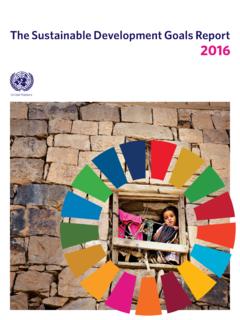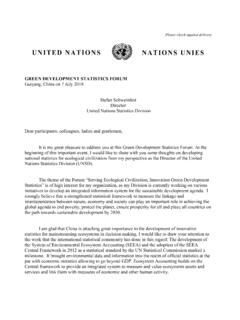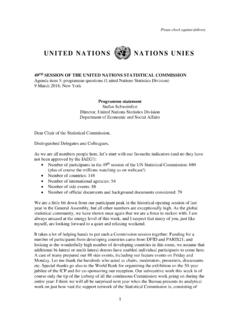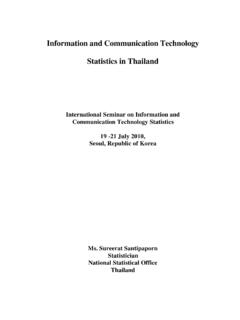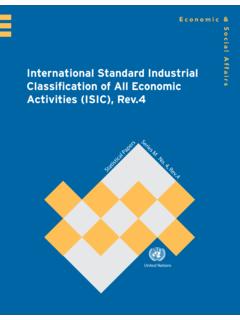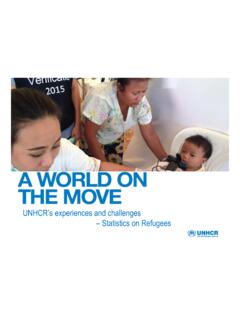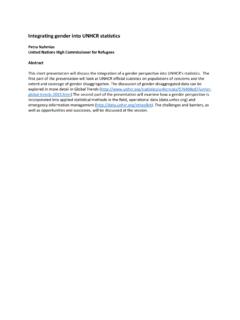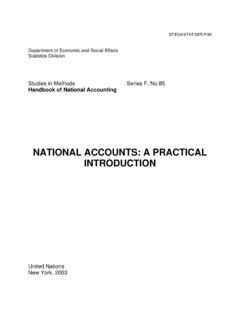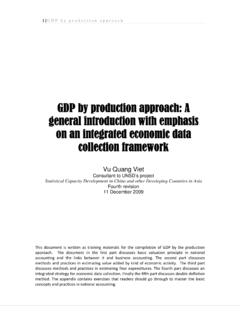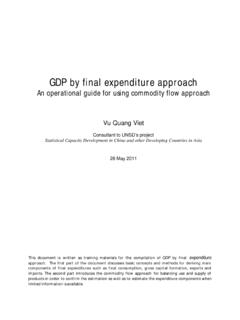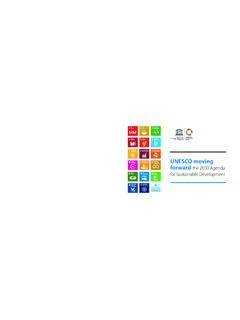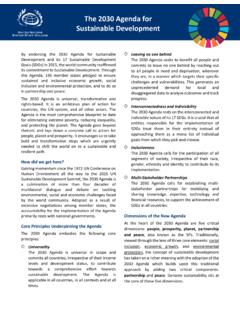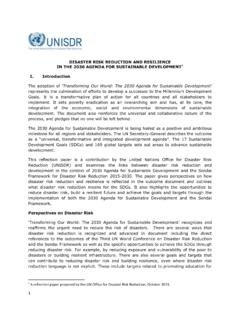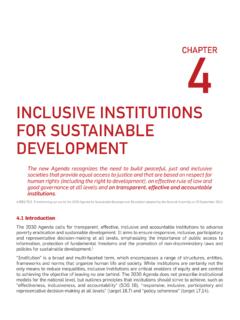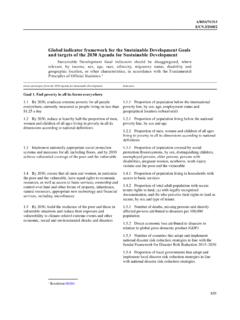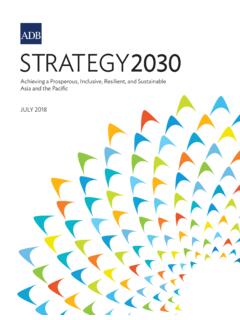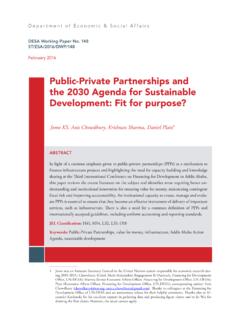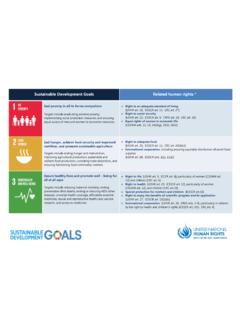Transcription of Global indicator framework for the Sustainable Development ...
1 A/RES/71/313 1/21 Global indicator framework for the Sustainable Development Goals and targets of the 2030 agenda for sustainable development Sustainable Development Goal indicators should be disaggregated, where relevant, by income, sex, age, race, ethnicity, migratory status, disability and geographic location, or other characteristics, in accordance with the Fundamental Principles of Official Goals and targets (from the 2030 agenda for sustainable development ) Indicators Goal 1.
2 End poverty in all its forms everywhere By 2030, eradicate extreme poverty for all people everywhere, currently measured as people living on less than $ a day Proportion of the population living below the international poverty line by sex, age, employment status and geographic location (urban/rural) By 2030, reduce at least by half the proportion of men, women and children of all ages living in poverty in all its dimensions according to national definitions Proportion of population living below the national poverty line, by sex and age Proportion of men, women and children of all ages living in poverty in all its dimensions according to national definitions Implement nationally appropriate social protection systems and measures for all, including floors.
3 And by 2030 achieve substantial coverage of the poor and the vulnerable Proportion of population covered by social protection floors/systems, by sex, distinguishing children, unemployed persons, older persons, persons with disabilities, pregnant women, newborns, work-injury victims and the poor and the vulnerable By 2030, ensure that all men and women, in particular the poor and the vulnerable, have equal rights to economic resources, as well as access to basic services, ownership and control over land and other forms of property, inheritance, natural resources, appropriate new technology and financial services, including microfinance Proportion of population living in households with access to basic services Proportion of total adult population with secure tenure rights to land, (a) with legally recognized documentation, and (b)
4 Who perceive their rights to land as secure, by sex and type of tenure By 2030, build the resilience of the poor and those in vulnerable situations and reduce their exposure and vulnerability to climate-related extreme events and other economic, social and environmental shocks and disasters Number of deaths, missing persons and directly affected persons attributed to disasters per 100,000 population Direct economic loss attributed to disasters in relation to Global gross domestic product (GDP) Number of countries that adopt and implement national disaster risk reduction strategies in line with the Sendai framework for Disaster Risk Reduction 2015 2030 Proportion of local governments that adopt and implement local disaster risk reduction strategies in line with national disaster risk reduction strategies _____ 1 Resolution 68/261.
5 A/RES/71/313 2/21 Goals and targets (from the 2030 agenda for sustainable development ) Indicators Ensure significant mobilization of resources from a variety of sources, including through enhanced Development cooperation, in order to provide adequate and predictable means for developing countries, in particular least developed countries, to implement programmes and policies to end poverty in all its dimensions Total official Development assistance grants from all donors that focus on poverty reduction as a share of the recipient country s gross national income Proportion of total government spending on essential services (education, health and social protection)
6 Create sound policy frameworks at the national, regional and international levels, based on pro-poor and gender-sensitive Development strategies, to support accelerated investment in poverty eradication actions Pro-poor public social spending Goal 2. End hunger, achieve food security and improved nutrition and promote Sustainable agriculture By 2030, end hunger and ensure access by all people, in particular the poor and people in vulnerable situations, including infants, to safe, nutritious and sufficient food all year round Prevalence of undernourishment Prevalence of moderate or severe food insecurity in the population, based on the Food Insecurity Experience Scale (FIES)
7 By 2030, end all forms of malnutrition, including achieving, by 2025, the internationally agreed targets on stunting and wasting in children under 5 years of age, and address the nutritional needs of adolescent girls, pregnant and lactating women and older persons Prevalence of stunting (height for age <-2 standard deviation from the median of the World Health Organization (WHO) Child Growth Standards) among children under 5 years of age Prevalence of malnutrition (weight for height >+2 or <-2 standard deviation from the median of the WHO Child Growth Standards) among children under 5 years of age, by type (wasting and overweight) Prevalence of anaemia in women aged 15 to 49 years, by pregnancy status (percentage)
8 By 2030, double the agricultural productivity and incomes of small-scale food producers, in particular women, indigenous peoples, family farmers, pastoralists and fishers, including through secure and equal access to land, other productive resources and inputs, knowledge, financial services, markets and opportunities for value addition and non-farm employment Volume of production per labour unit by classes of farming/pastoral/forestry enterprise size Average income of small-scale food producers, by sex and indigenous status By 2030, ensure Sustainable food production systems and implement resilient agricultural practices that increase productivity and production, that help maintain ecosystems, that strengthen capacity for adaptation to climate change, extreme weather, drought, flooding and other disasters and that progressively improve land and soil quality Proportion of agricultural area under productive and Sustainable agriculture By 2020, maintain the genetic diversity of seeds.
9 Cultivated plants and farmed and domesticated animals and their related wild species, including through soundly managed and diversified seed and plant banks at the national, regional and international levels, and promote access to and fair and equitable sharing of benefits arising from the utilization of genetic resources and associated traditional knowledge, as internationally agreed Number of plant and animal genetic resources for food and agriculture secured in either medium- or long-term conservation facilities Proportion of local breeds classified as being at risk of extinction A/RES/71/313 3/21 Goals and targets (from the 2030 agenda for sustainable development )
10 Indicators Increase investment, including through enhanced international cooperation, in rural infrastructure, agricultural research and extension services, technology Development and plant and livestock gene banks in order to enhance agricultural productive capacity in developing countries, in particular least developed countries The agriculture orientation index for government expenditures Total official flows (official Development assistance plus other official flows) to the agriculture sector Correct and prevent trade restrictions and distortions in world agricultural markets, including through the parallel elimination of all forms of agricultural export subsidies and all export measures with equivalent effect, in accordance with the mandate of the Doha Development Round Agricultural export subsidies Adopt measures to ens
